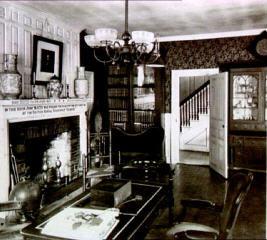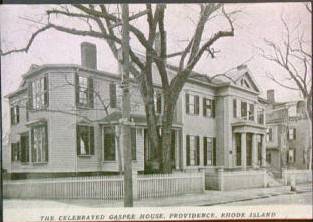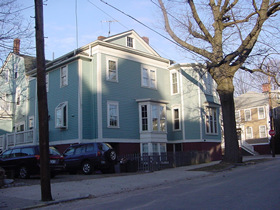| The
History of the Sabin Tavern by Dr. John Concannon
Webmaster, Gaspee Virtual Archives |
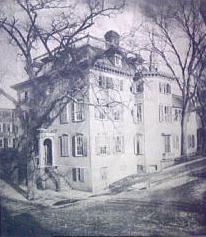 Left: Sabin Tavern c1880. The South-East Room, where the Gaspee Raiders met, can be seen behind the tree on the right side of the picture. The octagonal end of the room, while not original, marks its location. Providence Public Library Collection wc 688.1 The house structure to the right (behind the tree) is not part of the Sabin Tavern but is instead the "Half-House" of Gaspee Raider Abial Brown. Click to enlarge It was in the South-East room of this tavern on the evening of June 9, 1772, Rhode Island patriots met and made plans to burn the British revenue schooner HMS Gaspee. The patriots even cast their bullets in the tavern fireplace, and it was from across the Main Street at Fenner's Wharf that the brave men from Providence departed in their longboats to attack the Gaspee. The site of the Sabin Tavern was originally part of the
1640 grant to William Burrows and then subsequently
owned by the Lanham family. According to An
Address by Edward Field entitled "A Night at Sabin's
Tavern", Sabin's tavern was
the former home of Captain Woodbury Morris, mariner,
he having purchased the estate from Joseph Whipple, 13
Jun 1757 for ₤1200 and built the house soon after
[1761]. Seven years later Captain Morris, while on a
voyage to sea, died on the coast of Africa. On the
second day of December, 1765, Mary Morris, the
captain's widow, wrote in a little memorandum book,
wherein her husband had formerly kept his accounts,
and which she had continued to use: "Then Mr. Sabin
moved into my house. From this time until
December, 1773, James Sabin lived here, and catered to
the wants of man and beast, but on this date he
purchased a tract of land on the west side of the
river, near the Great Bridge, about where the
Merchants Bank Building now stands, and left the
tavern." James Sabin
took the name with him and reestablished the Sabin
Tavern nearer Market Square. (See
more about James Sabin and his later Sabin's Tavern) The house was then
purchased in 1785 by Welcome
Arnold, a distinguished merchant of Providence,
whose first house still stands further up on Planet
Street. He made many additions to the structure, and
occupied it as his residence until his death in 1798.
It remained in the Arnold family for more than a
hundred years. During their occupancy of the house,
the room wherein the 'Gaspee' party met was used as a
dining room, and there, on the wall, hung, for many
years, an account of the affair, prepared by Colonel Ephraim
Bowen, the last survivor of the party, and
engrossed by the hand of his daughter. Welcome Arnold
passed the ex-tavern onto his eldest
son, Samuel Greene Arnold, who then passed it on to
Samuel's younger brother Colonel Richard James Arnold,
for which it was used as his personal residence in the
1830s. "It is probable that the basement contained fully-usable space not counted as a story and the hip roof contained an extra half-story or at least a good garret. It is also probable that the main entrance was situated well above the South Main level (a characteristic of surviving nearby houses)."By 1823 a two story brick addition had been constructed on the back of the building and by 1851 a third story was added transitioned what was probably a Colonial style structure to a rather grotesque Italianesque-Victorian building as seen in the photos c1880. According to an article appearing in the Newsletter of the Warwick Historical Society, May 1990, The house was originally constructed as a double wooden framed house of two stories. There was a wide hall inside which extended completely through the house from front to rear. This was very beautiful because of the rich paneling, about four feet high. From this hallway a fine old staircase with old-fashioned balustrade and a paneled side led to the second floor.....In 1820, [Richard J. Arnold] added an ell of brick to the house with an entrance through an archway into the "Gaspee Room". A good many years afterwards he built a third story to the house and put an octagonal end on the famous southwest room. Over time the river front was filled in and what is now
Water Street was created, in effect moving South Main
Street one block further away from the Woonasquatucket
River that was central to the town. Fenner's Wharf
most likely lied below what is now The Packet Building
at 155 South Main Street. In 1772 there was only one
Main Street which only later was differentiated into
North and South Main Street based on their directions
from the city center at Market House. The Sabin Tavern
lot adjoined that of the later Abial Brown
"Half-House" on Planet Street. Abial Brown was also one
of the known participants in the attack. Circa 1780
Welcome Arnold also had another house built that still
exists on the other side of the where the Abial Brown
House once stood. By 1889, the old Sabin Tavern building had fallen into disrepair, and shifting demographics had made the neighborhood less desirable The Providence Journal said that "the house was dilapidated, and the bank had foreclosed on the mortgage with the building to be demolished." Again, per The Gaspee Room, pamphlet, Providence, Old Stone Bank, 1931, later republished in Warwick Historical Society Newsletter, May 1990
As it turns out, Mrs. Talbot was married to a descendant of Capt. Silas Talbot, a suspected Gaspee Raider. We note that only the original 2 stories of the Gaspee Room were moved; the third story added c1823-1851 was demolished along with the rest of the remnants of the "Sabin Tavern" in 1891. According to an article "Revolutionary Relics in the Room Where Burning of the Gaspee Was Planned", Providence Sunday Journal June 5, 1910, Sec 4:7 the Gaspee Room was used as the library for the Talbot House, and was also used as the meeting room for the DAR. A Providence Journal article of 1975 relates that by 1975 the membership of the Daughters of the American Revolution had dropped and the building was given to the Rhode Island Historical Society. The Society sold the building in 1983 and it is now used as an apartment house. 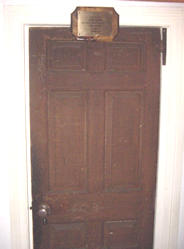 Left: Sabin
Tavern Door installed into wall of the current Pawtuxet
Rangers Armory. Left: Sabin
Tavern Door installed into wall of the current Pawtuxet
Rangers Armory. In 1961, the Gaspee Building (c1891-1961), a large two story structure that had been built on the site of the original tavern at the South Main Street and Planets Street was being demolished when beneath the rubble the wreckers discovered parts of the old Sabin Tavern. A Warwick resident salvaged the original door and gave it to the Gaspee Day Committee c1970. The Rhode Island Historical Society stored the door for many years before it was loaned to the Warwick Museum. In 1988, the Gaspee Day Committee voted to let the Pawtuxet Rangers keep the old door in their headquarters, the old Masonic Hall at the corner of Remington and Bank Streets, Warwick. 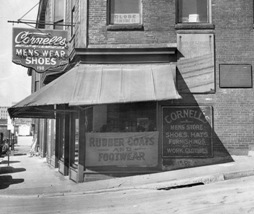 Right: The
Gaspee Building c1952, courtesy Providence
Journal. Click to see close-up of
memorial plaques. Right: The
Gaspee Building c1952, courtesy Providence
Journal. Click to see close-up of
memorial plaques. The old Gaspee Building that had built over the Sabin Tavern site at 182-198 South Main Street had two historical markers attached to south-facing outside wall. The slate plaque was saved during demolition of the building, and was kept in a Warwick location for a time, exposed to the elements in someone's backyard. Later, it was rescued by a man who proudly displayed the slate plaque affixed to his living room wall on Bridge Street in Pawtuxet Village. Below: The Gaspee Building slate marker for the Sabin Tavern 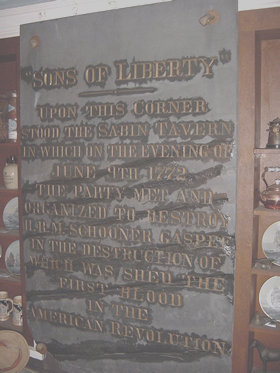 ------------------------ UPON THIS CORNER STOOD THE SABIN TAVERN IN WHICH ON THE EVENING OF JUNE 9TH 1772 THE PARTY MET AND ORGANIZED TO DESTROY H.R.M SCHOONER GASPEE IN THE DESTRUCTION OF WHICH WAS SHED THE FIRST BLOOD IN THE AMERICAN REVOLUTION 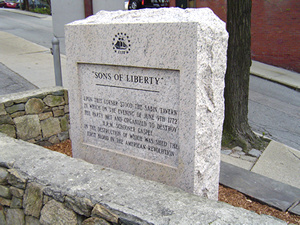
Left: Present
(2004) Sabin Tavern memorial granite marker in
parking lot of the office building at 180 South Main Street. Wording
is kept exactly as original.
Sometime coincident with the construction of the IBM
Building in 1962 (now an office building) a large granite memorial stone
containing an inset slate marker was erected.
The engraved slate section was pried out and stolen
c1980, but the beautiful granite marker was restored,
engraved, and re-dedicated in June 2004. Right: Recovered Sabin Tavern Slate Marker In 2010 the slate plaque was recovered from a home being renovated by the City of East Providence. The plaque is now displayed in the Aspray Boat House, the headquarters of the Gaspee Days Committee. |
 Left: Planet Street side of
restored granite marker Left: Planet Street side of
restored granite markerThe Gaspee Days Committee extends its sincere appreciation to the following organizations that contributed to the completion of this project: The Champlin Foundations
Partridge, Snow, & Hahn, LLP Rhode Island Supreme Court Historical Society Fund Stanley Granite Company, Inc. City of East Providence. |
 History
Files
History
Files Right:
Colorized postcard of Sabin Tavern photo c1880.
Providence Public Library collection pc7142.
Right:
Colorized postcard of Sabin Tavern photo c1880.
Providence Public Library collection pc7142.
